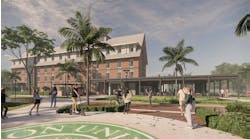A 15-year effort to build a school in Chicago is underway, but workers have to proceed carefully to avoid disturbing human remains that may lie beneath the soil.
The Chicago Tribune reports that the $70 million school is to be built on the grounds of a former Cook County Poor House on the city's Northwest Side. An estimated 38,000 people were buried in unmarked graves at the site.
Workers have until April 27 to excavate and clear the site, remediate the soil and relocate an existing sewer line. The school is scheduled to open in 2019-20 academic year. The site contracts indicate it will be a middle school, but Ald. Nicholas Sposato says he is confident the campus will be either a four-year high school for the Dunning neighborhood or a freshman academy for Taft High School.
Bid documents from Chicago's Public Building Commission say the Reed Dunning School will consist of a three-story academic wing and a one-story athletic wing connected by a high-ceiling, one-story link, which also serves as the main entry to the school. The school program will include standard classrooms, science and specialty classrooms, computer labs, administrative and support areas, gymnatorium with stage, kitchen, dining room and music suite.
At 135,000 square feet, the school will accommodate about 1,200 students.
Children, patients from an infirmary and a tuberculosis hospital, victims of the Great Chicago Fire of 1871 and Civil War veterans were laid to rest in what is known as the Dunning grounds, a 320-acre stretch on the city’s Northwest Side.
In 1854, the county opened a poorhouse and farm and gradually added an insane asylum, infirmary and tuberculosis hospital to the property. At its peak, a thousand people a year were buried on the grounds.
The state took over in 1912 and changed the official name to Chicago State Hospital. Buildings were shuttered in 1970. Today, the cemeteries are bounded by restaurants, businesses, houses and condominiums.
Workers who were building single-family homes and installing sewer lines in the area unearthed bodies in 1989 and again in 1995.
Should workers come across intact graves, officials will set up a perimeter with police tape, post warning signs and secure the area. The architects would then go in and remove the coffins and grave artifacts, place them in plastic storage containers and move them to a staging area before resuming work.


